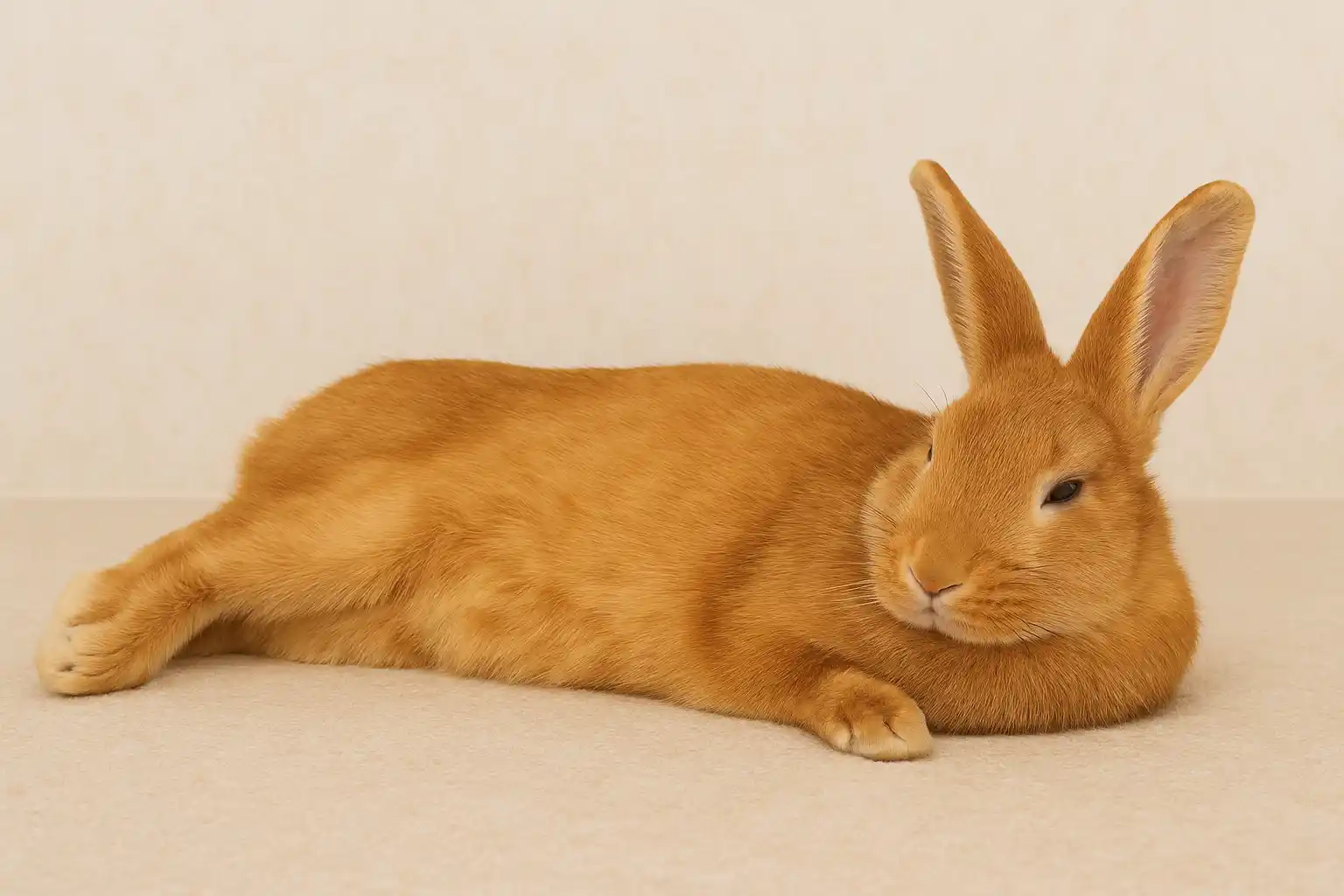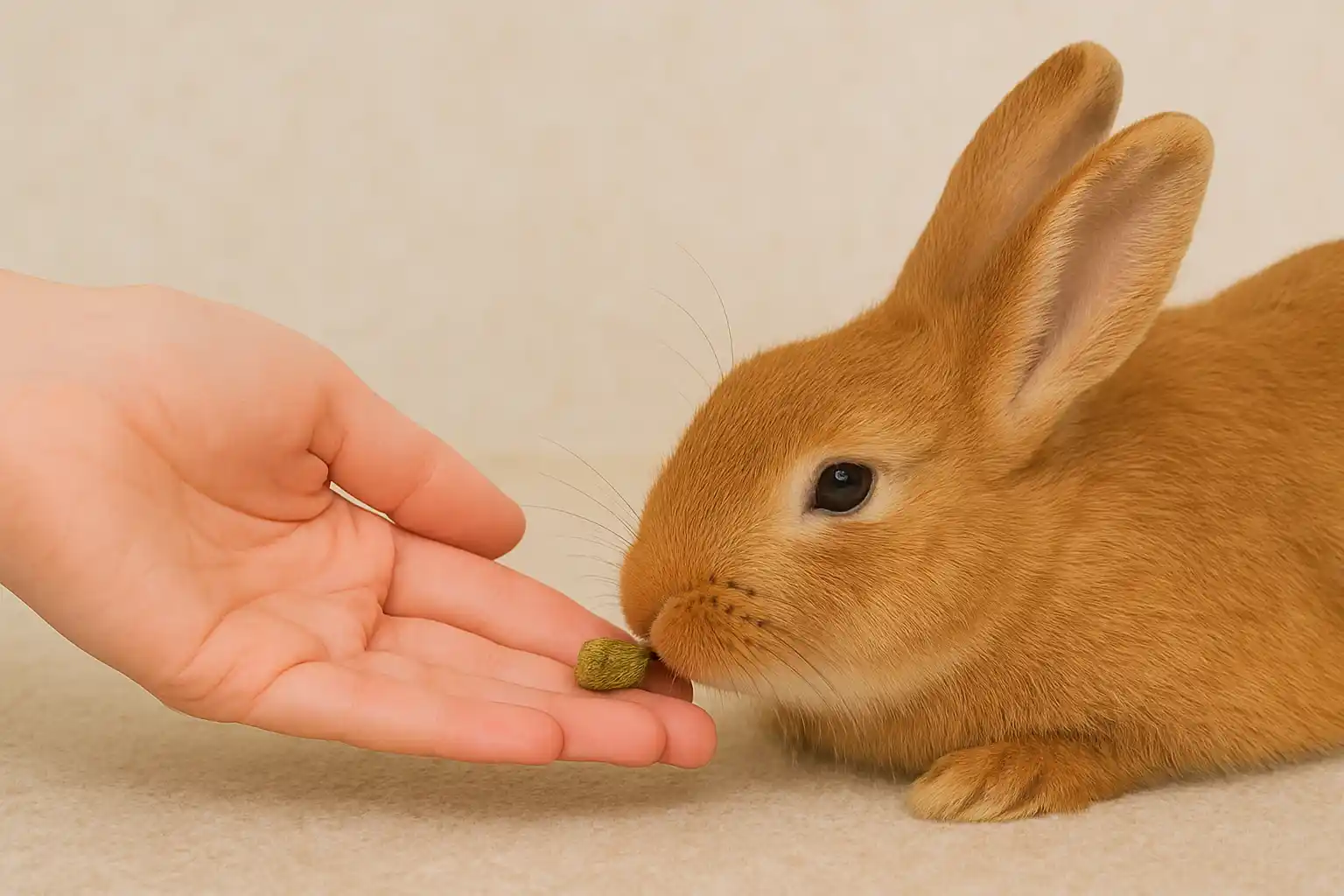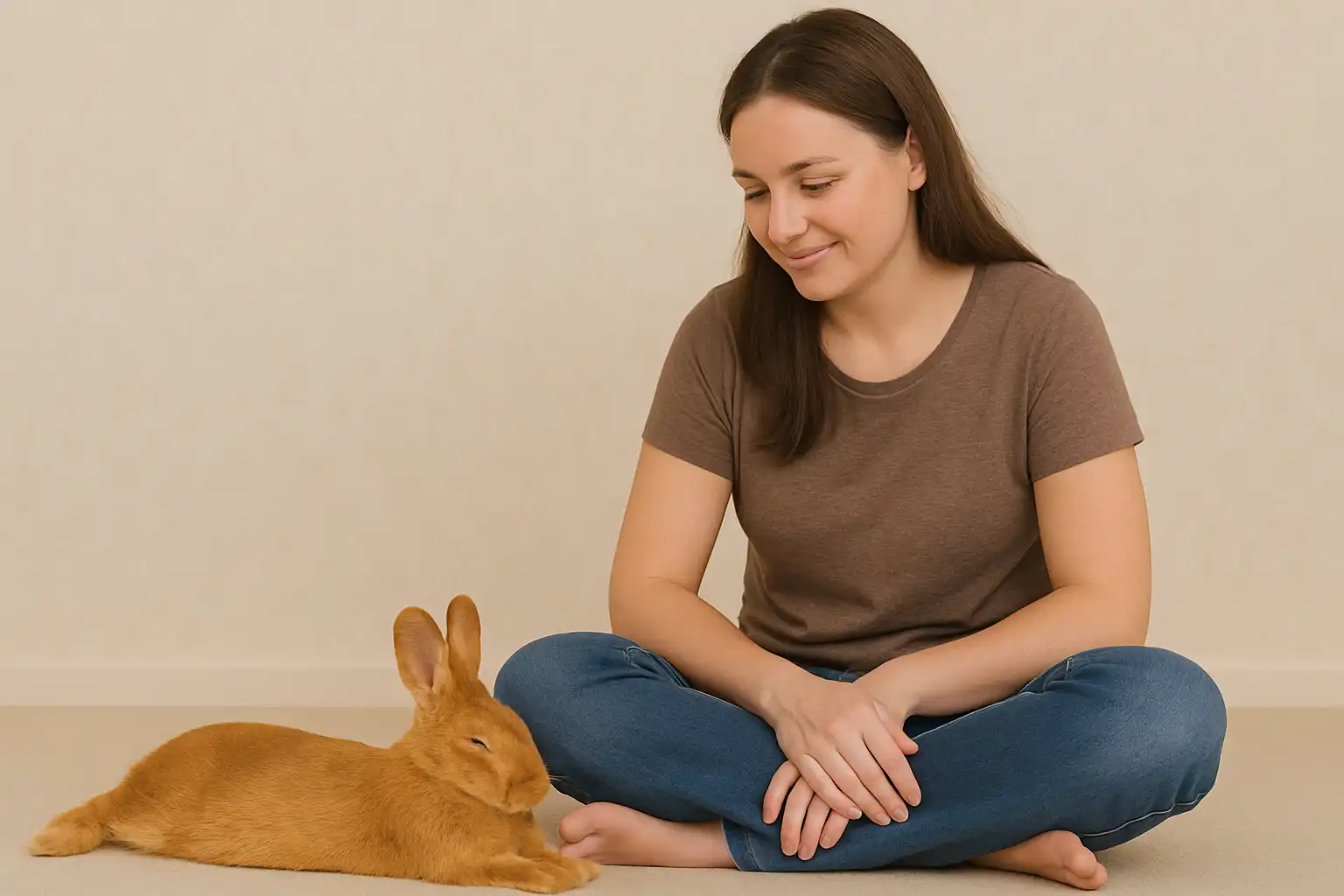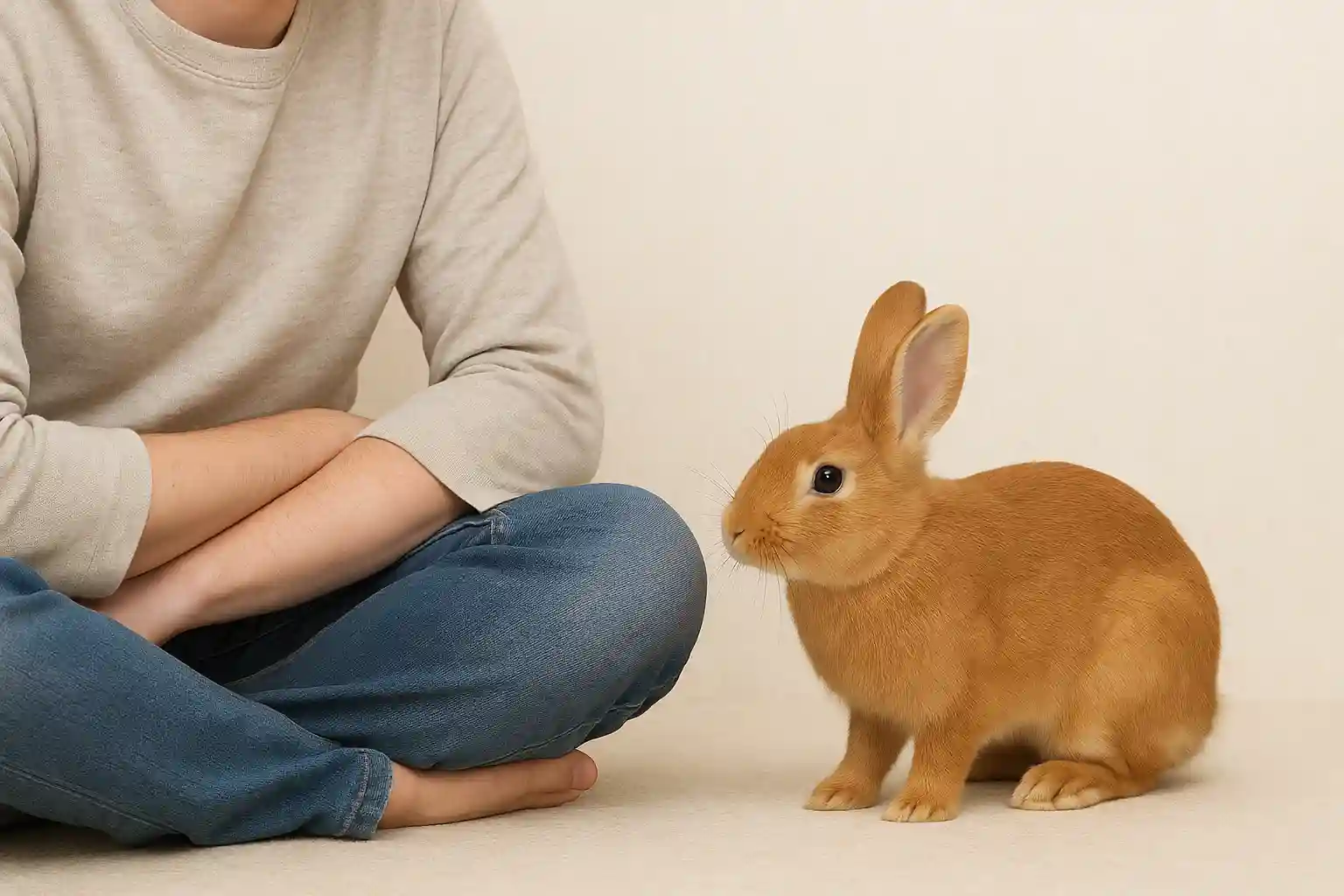Learning how to bond with your bunny takes patience and understanding. This expert guide shares proven techniques to create a lasting bond with your bunny, from creating the perfect environment to learning their unique language.
When I brought home my first rabbit, Thumper, I was baffled by his tendency to hide whenever I entered the room. It took me weeks to realize that learning how to bond with your bunny isn’t like bonding with a dog or cat—it requires a completely different approach. After years of rabbit ownership and countless hours of patient interaction, I’ve discovered that bonding with your bunny is both an art and a science that rewards consistency and gentle persistence.
Rabbits are prey animals by nature, making trust the foundation of any meaningful connection. Whether you’ve just brought home a new bunny or you’re looking to deepen your relationship with a long-time fluffy companion, this guide will walk you through proven methods to build that special bond that makes rabbit ownership so rewarding. Let me share how to bond with your bunny in ways that respect their natural behaviors and instincts.
Understanding Bunny Behavior for Bonding
Before you can effectively bond with your bunny, you need to understand how they communicate and what drives their behavior. This knowledge forms the foundation of a trusting relationship and is essential to the bonding process.
Common Bunny Behaviors that Indicate Bonding
Rabbits have a unique language of love and trust that differs significantly from other pets. Learning to recognize these signals is crucial when discovering how to bond with your bunny effectively. When my rabbit Thumper started following me from room to room, I knew our relationship had turned a corner. This “shadowing” behavior is one of the clearest signs that your bunny considers you part of their social circle.
Watch for these positive bonding signals:
- Flopping: When a rabbit flops onto their side, exposing their vulnerable belly, they’re showing they feel completely safe in your presence.
- Binkying: These joyful jumps and mid-air twists are pure expressions of happiness.
- Nose bonking: A gentle nudge with their nose is often a rabbit’s way of saying “pay attention to me” or “I like you.”
- Licking: If your bunny licks your hand or clothes, treasure this moment—it’s their version of grooming you, which is a significant social bonding behavior.
- Purring: A soft grinding of their teeth (different from loud painful grinding) indicates contentment when you’re petting them.

Understanding these behaviors helps you recognize when your bond is strengthening. Conversely, thumping, hiding, or nipping usually indicates fear or displeasure that needs addressing.
Signs of Trust in Your Bunny
Trust develops gradually with rabbits, and recognizing the milestones will help you gauge your progress. The first time Thumper took a treat from my hand without hesitation was a moment I’ll never forget—it meant he no longer saw me as a potential threat.
Key trust indicators include:
- Taking food directly from your hand
- Relaxed body posture when you enter the room (no freezing or darting away)
- Willingness to hop onto your lap without coaxing
- Sleeping in your presence with eyes closed
- Coming when called or when you enter the room
- Accepting handling without struggling
Each rabbit develops trust at their own pace, so patience is essential. My second rabbit, Daisy, took nearly six months to show the same signs your bunny trusts you that Thumper displayed after just a few weeks. Remember that your bunny’s personality and past experiences significantly influence their willingness to bond.
How to Bond with Your Bunny Through Environment
The setting in which you interact with your bunny plays a crucial role in how quickly trust develops. Creating the right environment can accelerate the bonding process dramatically and is a key component in learning how to bond with your bunny successfully.
Ideal Spaces for How to Bond with Your Bunny
I learned the hard way that trying to bond with Thumper in our busy, noisy kitchen was counterproductive. Rabbits need calm, quiet spaces where they feel secure enough to let their guard down.
Consider these environmental factors:
- Flooring: Choose a non-slip surface like carpet or a rug where your bunny can move confidently without scrambling.
- Noise level: Keep television and music volume low, and avoid sudden loud noises.
- Temperature: Maintain a comfortable 65-75°F (18-24°C) range, as rabbits are sensitive to heat.
- Escape routes: Always provide visible “exits” so your bunny doesn’t feel trapped.
- Familiar territory: Start bonding sessions in areas your rabbit already knows before introducing new spaces.
I created a “bonding corner” in our living room with Thumper’s favorite toys, a comfortable rug, and some hiding spots. This dedicated space became our special meeting place where positive associations grew stronger with each interaction.
Safe Toys When Learning How to Bond with Your Bunny
Interactive play builds trust while satisfying your rabbit’s natural instincts. When I introduced Thumper to his first willow ball, it transformed our bonding sessions from passive sitting to active engagement.
The best bonding toys include:
- Foraging toys: Puzzle feeders that dispense treats encourage your bunny to associate your presence with positive experiences.
- Natural chew toys: Untreated willow, apple, or bamboo items satisfy chewing needs while providing bonding opportunities.
- Tunnel systems: These create hide-and-seek games that many rabbits love, especially when you participate.
- Cardboard castles: Simple structures made from untreated cardboard boxes with multiple entrances/exits provide enrichment.
- Digging boxes: A shallow container filled with shredded paper or chemical-free soil allows for natural digging behavior.
Always supervise play sessions and remove any toys that your rabbit begins to consume inappropriately. The right toys transform bonding from a passive activity into an engaging interaction that builds lasting connections.
How to Bond with Your Bunny: Essential Techniques
The way you approach and interact with your bunny fundamentally shapes their perception of you. Understanding proper rabbit body language and using appropriate bonding techniques are essential when learning how to bond with your bunny. These methods have proven effective across many rabbit personalities.
Effective Ways to Approach Your Bunny
My earliest mistake with Thumper was approaching him directly from above, which triggered his prey instincts. Learning how to bond with your bunny properly starts with approaching at eye level, which revolutionized our relationship.
Practice these approach techniques:
- Get low: Sit or lie on the floor to appear less threatening.
- Move slowly: No sudden movements that might startle your bunny.
- Avoid reaching: Don’t reach directly for your rabbit—let them come to you.
- Indirect approach: Move at an angle rather than head-on toward your bunny.
- Be patient: If your rabbit seems nervous, pause and give them time to adjust.
- Use treats wisely: Offer a small treat from an open palm without forcing interaction.

I found that reading a book while sitting on the floor near Thumper’s space worked wonders. It allowed him to investigate me on his terms, without pressure. Within a week, his curiosity overcame his caution, and he began approaching me voluntarily.
Techniques for Physical Bonding with Your Bunny
Physical contact is a delicate matter with rabbits. Most don’t naturally enjoy being picked up, as it mimics being captured by a predator. When learning how to bond with your bunny, focus on ground-level interactions that respect their dignity and agency.
Effective physical bonding methods:
- Start with brief touches: Quick, gentle pets on the forehead or between the ears.
- Gradually extend petting time: As your bunny becomes comfortable, slowly increase duration.
- Learn proper petting zones: Most rabbits prefer being touched on their head, cheeks, and back—avoid the sensitive belly and feet initially.
- Practice proper lifting technique: When necessary, support both the hindquarters and chest, keeping your bunny close to your body.
- Try “bunny massage”: Gentle circular motions at the base of the ears often elicit purring.
I discovered that Thumper loved having the base of his ears massaged but disliked being touched on his sides. Each rabbit has unique preferences, so pay attention to your bunny’s reactions and respect their boundaries.
How to Speak to Your Bunny: Vocalization and Sounds
Rabbits are generally quiet animals, but they’re remarkably responsive to human vocalizations when used consistently. Understanding how to bond with your bunny through vocal communication helps them recognize you and fosters comfort.
Communication tips that work:
- Use a soft, consistent tone: I always greet Thumper with the same gentle “hello bunny” phrase.
- Name recognition: Use your rabbit’s name frequently during positive interactions.
- Humming: Soft humming can be soothing and signals your peaceful intentions.
- Warning sounds: Create a specific sound before necessary disturbances (like cage cleaning) to build predictability.
- Clicking: Some rabbits respond well to clicker training as a communication tool.
Avoid loud vocalizations, shouting, or sudden noises. I noticed that Thumper became noticeably more relaxed when I maintained a quiet, gentle speaking voice specifically for our interactions. Remember that much of your “conversation” with your bunny will be non-verbal, through consistent handling and responsive care.
Activities to Strengthen Your Bond
Shared activities create the foundation for deep, lasting bonds. Understanding how to bond with your bunny through purposeful interactions builds your relationship while providing essential enrichment for your rabbit’s social needs and mental stimulation.
Playtime Activities for Bunnies
Structured play sessions not only strengthen your bond but also provide crucial exercise for your rabbit’s physical and mental health. Learning how to bond with your bunny through play creates positive associations. When I introduced “tunnel time” with Thumper, our relationship reached new heights of trust and enjoyment.
Try these bonding activities:
- Obstacle courses: Create simple jumps and tunnels using household items.
- Treat treasure hunts: Hide small treats around a rabbit-proofed room.
- Paper crumple play: Roll up brown paper into balls for your bunny to toss and shred.
- Follow the leader: Encourage your bunny to follow you through a safe play area.
- Gentle chase games: Some rabbits enjoy being “chased” at a distance as they hop away playfully.

I set aside 20 minutes each evening for dedicated play with Thumper. This consistency helped him anticipate positive interaction time with me, reducing anxiety and building excitement for our bonding sessions.
Training Your Bunny for Bonding
Training might seem ambitious for a rabbit, but simple commands and routines build communication and trust while providing mental stimulation. The first time Thumper came when called was a breakthrough moment in our relationship.
Start with these training basics:
- Name recognition: Call your bunny’s name before offering treats.
- Target training: Teach your rabbit to touch a target stick for rewards.
- Simple commands: “Come,” “Up” (for jumping onto permitted surfaces), and “Circle” are achievable starter commands.
- Clicker training: Associate a clicking sound with treats, then use it to mark desired behaviors.
- Litter training reinforcement: Praise and treats for proper litter box usage strengthens trust.
Keep training sessions brief (3-5 minutes) and always end on a positive note. I trained Thumper to come when called, which not only impressed friends but created a ritual that bonded us through shared achievement and communication.
The Importance of Grooming in Bonding
Grooming is a powerfully bonding activity in rabbit society. When rabbits groom each other, they’re expressing social bonds and hierarchy. Participating in gentle grooming mimics this natural bonding behavior. Grooming sessions are excellent opportunities to practice how to bond with your bunny through physical contact.
Effective grooming strategies:
- Start slowly: Begin with very brief, gentle brushing sessions.
- Use appropriate tools: Soft-bristled brushes or clean hands for short-haired rabbits; specialized slicker brushes for Angoras or other long-haired breeds.
- Focus on positive areas: Most rabbits enjoy being groomed on their forehead and cheeks.
- Reward liberally: Offer treats and praise during and after grooming.
- Respect signals: If your bunny hops away, don’t force continued grooming.
During shedding season, daily grooming becomes essential for health and provides extra bonding opportunities. I found that grooming Thumper just before offering his favorite leafy greens created a positive association that helped him accept the handling more readily.
Troubleshooting Bonding Issues
Even with the best approaches, you may encounter challenges in your bonding journey. Understanding proper rabbit socialization and addressing these issues patiently will strengthen your relationship in the long run. Learning how to bond with your bunny sometimes involves working through obstacles.
Common Problems When Bonding with Bunnies
When Thumper went through a phase of nipping my ankles, I nearly gave up on our bonding progress. Research helped me understand this was communicative behavior, not aggression, and we worked through it successfully. Understanding body language is crucial when learning how to bond with your bunny effectively.
Watch for these common challenges:
- Thumping: Often indicates fear or displeasure with environmental changes.
- Nipping: Can signal territorial behavior or a request for attention.
- Lunging: May indicate fear, territorial protection, or hormonal behavior.
- Hiding persistently: Shows significant fear or insecurity.
- Overgrooming: Stress can trigger excessive self-grooming.
- Cage aggression: Some rabbits become defensive of their home space.
The key to resolving these issues lies in identifying triggers and addressing root causes rather than just the behaviors themselves. When Thumper started nipping, I realized it happened primarily when I was wearing unfamiliar shoes. Changing this simple factor improved our interactions immediately. These same techniques can be helpful if you’re trying to get a stray bunny to come to you, as they’re particularly likely to show fearful behaviors.
Solutions for Scared or Shy Bunnies
Some rabbits, particularly those with traumatic backgrounds, require extra patience and specialized approaches. My second rabbit, Daisy, came from a rescue situation and showed extreme fearfulness initially. These techniques for how to bond with your bunny are especially important with timid animals.
Techniques for timid bunnies:
- Extended adjustment time: Give your shy bunny several weeks to acclimate without pressure to interact.
- Predictable routines: Maintain consistent feeding, cleaning, and interaction schedules.
- Indirect bonding: Sit near the cage reading aloud without attempting physical contact.
- Height advantage: Provide elevated spaces where your bunny can observe from a position of security.
- Gradual exposure: Slowly increase interaction duration as tolerance builds.
- Consider pairing: Some shy rabbits gain confidence from bonding with a confident rabbit companion.
With Daisy, breakthrough came through what I call the “parallel play” method—sitting nearby engaged in my own activity while she explored at her own pace. After three months of this patient approach, she voluntarily hopped into my lap for the first time—a moment worth every minute of waiting.
Maintaining a Long-term Bond
Building a bond is just the beginning; maintaining it requires ongoing attention and care. Understanding the rabbit bonding timeline helps set realistic expectations about your relationship’s development. Long-term connections with rabbits can be incredibly rewarding when nurtured properly through consistent application of how to bond with your bunny techniques.
Signs You’ve Learned How to Bond with Your Bunny Successfully
A year into my relationship with Thumper, I realized we had developed a connection I never thought possible with a rabbit. Recognizing these signs helps you appreciate your progress and identify areas for continued growth.
Evidence of a strong bond includes:
- Seeking you out: Your bunny actively looks for you and follows you between rooms.
- Relaxed greeting: Your presence triggers relaxed ear position and perhaps a contented tooth purr.
- Grooming exchange: Your rabbit licks you unprompted during interactions.
- Physical closeness: Willingly sits beside you or on your lap for extended periods.
- Play initiation: Your bunny brings toys to you or invites chase games.
- Comfort in handling: Accepts necessary handling with minimal stress.
The most touching sign of Thumper’s trust came when he began sleeping pressed against my leg during evening relaxation time—a vulnerable position that spoke volumes about his comfort with me.
Routine Activities to Ensure a Lasting Connection
Like any relationship, your bond with your bunny requires ongoing maintenance through meaningful interactions. I found that establishing specific bonding rituals created a framework for our continued connection. These training activities demonstrate how to bond with your bunny through mutual learning and respect.
Effective long-term bonding activities:
- Daily floor time: Spend at least 30 minutes at rabbit-level each day.
- Weekly exploration: Introduce new toys or rearrange play areas to create shared novel experiences.
- Consistent feeding ritual: Hand-feeding portion of greens creates positive associations.
- Grooming sessions: Regular brushing maintains physical connection.
- Quiet companionship: Simply being present while your rabbit exercises maintains your bond.
- Verbal consistency: Use the same phrases and tones to create security.

I created a “Sunday Special” tradition with Thumper—a supervised outdoor playpen session (weather permitting) with special treats and toys. These consistent yet special experiences maintained our connection through the years of our companionship.
Remember that your rabbit’s needs may change with age, and adjusting your bonding activities accordingly shows respect for their changing capabilities while maintaining your special relationship.
Building a bond with your bunny is truly one of the most rewarding experiences in pet ownership. While it may require more patience than forming relationships with dogs or cats, the quiet trust of a bonded rabbit offers a unique and deeply satisfying connection. To start this journey, you may want to learn how to get a bunny to come to you first, as this is the foundation of any successful relationship. The methods described in this guide for how to bond with your bunny have been tested and refined through years of experience. By understanding rabbit psychology, creating the right environment, and using appropriate techniques for how to bond with your bunny, you’ll develop a relationship built on mutual respect and genuine affection.
FAQs About Bonding With Your Bunny
How long does it take to bond with a bunny?
Bonding with your bunny typically takes between 2 weeks and 3 months, depending on your rabbit’s temperament and previous experiences. Some rabbits may bond quickly within days, while shy or traumatized bunnies might need 6 months or more to fully trust you. Consistency in your approach and respecting your bunny’s boundaries will create the strongest bond.
How do I get my bunny to bond with me?
To bond with your bunny, spend quiet time sitting on the floor at their level, allowing them to approach you first. Offer healthy treats from an open palm, speak in soft tones, and avoid sudden movements. Establish a consistent daily routine for feeding and playtime. Never force interaction—let your bunny set the pace for physical contact as trust develops when learning how to bond with your bunny.
How do I make my rabbit more cuddly?
Make your rabbit more cuddly by building trust first through ground-level interactions rather than picking them up. Start with gentle head pets, gradually introducing longer stroking sessions as your bunny becomes comfortable. Reward calm behavior during handling with treats, and respect when they want to leave. Many rabbits prefer sitting beside you rather than being held.
Can a rabbit bond with a human?
Yes, rabbits absolutely can bond with humans, often forming deep, affectionate relationships. As social animals, rabbits in the wild live in groups and transfer this social behavior to humans when domesticated. When you learn how to bond with your bunny properly, they will seek you out, flop near you, groom you, and show excitement when you enter the room—clear signs of genuine attachment.

